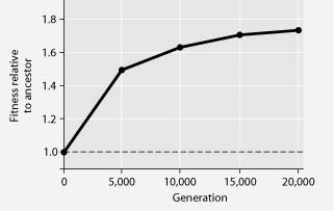Multiple Choice
The following question refers to the figure.
In this eight-year experiment, 12 populations of E. coli, each begun from a single cell, were grown in low-glucose conditions for 20,000 generations. Each culture was introduced to fresh growth medium every 24 hours. Occasionally, samples were removed from the populations, and their fitness in low-glucose conditions was tested against that of members sampled from the ancestral (common ancestor) E. coli population.
If the experimental population of E. coli lacks an F factor or F plasmid, and if bacteriophages are excluded from the bacterial cultures, then beneficial mutations might be transmitted horizontally to other E. coli cells via ________.
A) sex pili
B) transduction
C) conjugation
D) transformation
Correct Answer:

Verified
Correct Answer:
Verified
Q5: The following table depicts characteristics of
Q10: Use the following information and graph to
Q11: The following question refers to the figure.<br>In
Q13: If all prokaryotes on Earth suddenly vanished,
Q14: Biologists sometimes divide living organisms into two
Q14: The following question refers to the figure.<br>In
Q24: Use the following information to answer the
Q30: The thermoacidophile Sulfolobus acidocaldarius lacks peptidoglycan, but
Q36: Use the information in the following paragraph
Q56: Which of the following is least associated